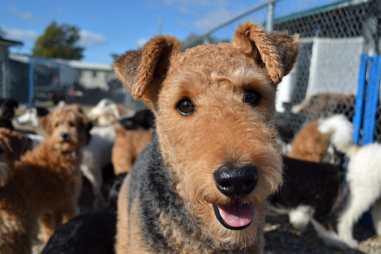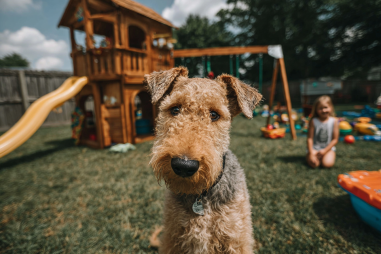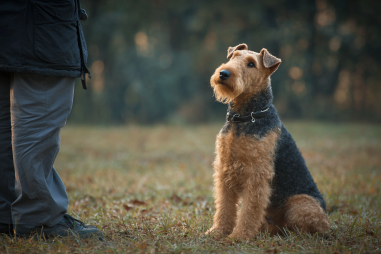Creating a comfortable and welcoming living environment for your Airedale Terrier is essential not only for their happiness but also for their overall health. This spirited breed, known as the “King of Terriers,” thrives when given appropriate space, mental stimulation, and a safe habitat that caters to their unique physical and emotional needs. Whether you live in an apartment or a house with a yard, understanding how to optimize your dog’s surroundings can make a remarkable difference in their well-being.
Understanding Airedale Terrier Space Needs
Airedale Terriers are medium to large-sized dogs with high energy levels and curious minds. These active dogs require sufficient room to move, play, and explore. Ideally, an environment that allows for both indoor freedom and access to an outdoor area is best. Cramped spaces or overly confined areas can lead to frustration, which might manifest as destructive behavior or excessive barking.
While they can adapt to smaller living spaces if provided ample outdoor exercise, Airedales generally thrive in homes where they can roam freely. Remember that these dogs are intelligent and need physical and mental outlets, so consider how much space you can realistically provide when setting up your living environment.
Indoor vs Outdoor Living Considerations
Deciding whether your Airedale Terrier’s primary living area will be indoors or outdoors depends on multiple factors, including climate, available space, and your lifestyle. While Airedales enjoy time outside to expend energy, they are very much household companions and should never be left entirely outdoors, especially not unsupervised for long periods.
Indoor living allows you to monitor your dog’s health, behavior, and comfort while building close bonds. However, this breed needs frequent outdoor activity, so having a routine for walks, play sessions, or access to a fenced yard is essential.
When considering outdoor time, make sure there’s adequate shelter and shaded areas to protect your dog from extreme weather conditions. This balance keeps your Airedale comfortable and secure.
Safe and Stimulating Yard Setup
If you have a yard, creating a secure and engaging outdoor space for your Airedale Terrier is a great way to enhance their living environment. A fenced-in yard with durable, high fencing is important because Airedales are known for their agility and curiosity, which might otherwise lead them to escape.
Make sure the fencing has no gaps or weak spots where your dog might squeeze through or dig under. Smooth, non-toxic grass or ground cover is ideal for playtime, and avoid plants that are toxic or harmful to dogs.
To keep things stimulating, include toys, tunnels, or digging areas that encourage natural behaviors. For example, a designated digging box can prevent your turf from being damaged and provide a mental outlet.
Climate and Shelter Recommendations
Airedale Terriers have a dense, wiry coat that offers some protection from cold and wet weather, but they are not built for extreme climates. Providing proper shelter from heat, cold, rain, and wind is a key component of their living environment.
In hot weather, always ensure your dog has access to plenty of fresh water and shaded areas to prevent overheating. Avoid prolonged outdoor exposure during peak sun hours. In colder seasons, a well-insulated doghouse or allowing access back inside the home is crucial to keep your Airedale warm and dry.
Indoor climate control benefits your dog year-round, as extreme temperatures can be stressful. Humidity and air quality also impact your dog’s skin and coat health, so maintaining a comfortable environment helps prevent discomfort and illness.
Environment Enrichment Ideas
Mental stimulation is just as important as physical exercise for an Airedale Terrier. These clever dogs enjoy problem-solving tasks and interactive play. Enrichment can be provided through puzzle toys, scent games, and training sessions that challenge their intelligence and keep boredom at bay.
Rotate toys regularly to maintain interest and introduce new challenges like hide-and-seek games or obedience practice. Access to chew toys also satisfies the instinctual urge to gnaw, promoting dental health and reducing destructive behaviors.
Consider setting up a comfy corner or crate where your dog can retreat to relax after playtime, associating that space with positive experiences.
Minimizing Hazards and Stressors
Ensuring your home and yard are free from hazards protects your Airedale Terrier from injury or illness. Common household dangers include toxic plants, chemicals, exposed wires, and small objects that could be swallowed.
Secure garbage bins and keep harmful substances out of reach. In the yard, avoid sharp tools or unstable structures that could cause harm. Regularly inspect the environment for potential risks and address them promptly.
Additionally, keep noise levels moderate, as loud or sudden sounds can stress dogs. Create a calming atmosphere using soft music or white noise if your home tends to be busy or noisy.
Suitable Bedding and Resting Areas
Comfortable resting spaces are vital for your Airedale’s recuperation and health. Choose a bed that is appropriately sized, supportive, and easy to clean. Orthopedic beds can be especially beneficial for senior dogs to ease joint discomfort.
Place bedding in a quiet, draft-free area where your dog feels safe from household traffic. Avoid placing the bed in direct sunlight or near heating vents to maintain a stable temperature.
It’s also good practice to provide multiple resting spots so your dog can choose where they feel most comfortable depending on their mood or the household environment.
Noise and Activity Level Management
Airedale Terriers are alert watchdogs that may bark at unfamiliar sounds or activity. Managing noise and household activity can reduce stress for your dog and help prevent excessive barking.
Establish routines to create predictability and reassurance. If your area is noisy, soundproofing or white noise machines may soothe your dog. Provide distraction through toys or calming activities during louder times.
Regular exercise helps reduce pent-up energy that could otherwise turn into vocalization or destructive behavior related to stress.
Adapting the Home for Puppy and Senior Phases
Puppies and senior Airedales have different needs that affect how you design their living spaces. Puppies require extra supervision and safe zones to prevent accidents or destructive chewing. Use baby gates or playpens to section off puppy-friendly areas and remove hazards.
Seniors may need more accessible spaces to avoid jumping or climbing stairs that could strain aging joints. Soft bedding, non-slip flooring, and easy access to water and food bowls support their comfort.
Adjust activity levels and mental engagement to match energy and mobility changes as your dog ages, ensuring their environment remains suitable throughout their life stages.
Setting Up the Perfect Space for Your Airedale Terrier
Living with an Airedale Terrier means embracing their spirited nature and providing a home that supports their physical and emotional needs. To sum up, consider these key elements as you create the ideal living environment:
- Ample space for movement both indoors and outdoors
- Secure and stimulating yard setup
- Weather-appropriate shelter with climate control
- Engaging environmental enrichment
- Safe, hazard-free surroundings
- Comfortable bedding and resting spots
- Noise and activity management tailored to reduce stress
- Adaptations for puppy and senior stages
By thoughtfully addressing these areas, your Airedale Terrier can thrive in a nurturing and balanced home that encourages them to be their best, happiest self every day.







